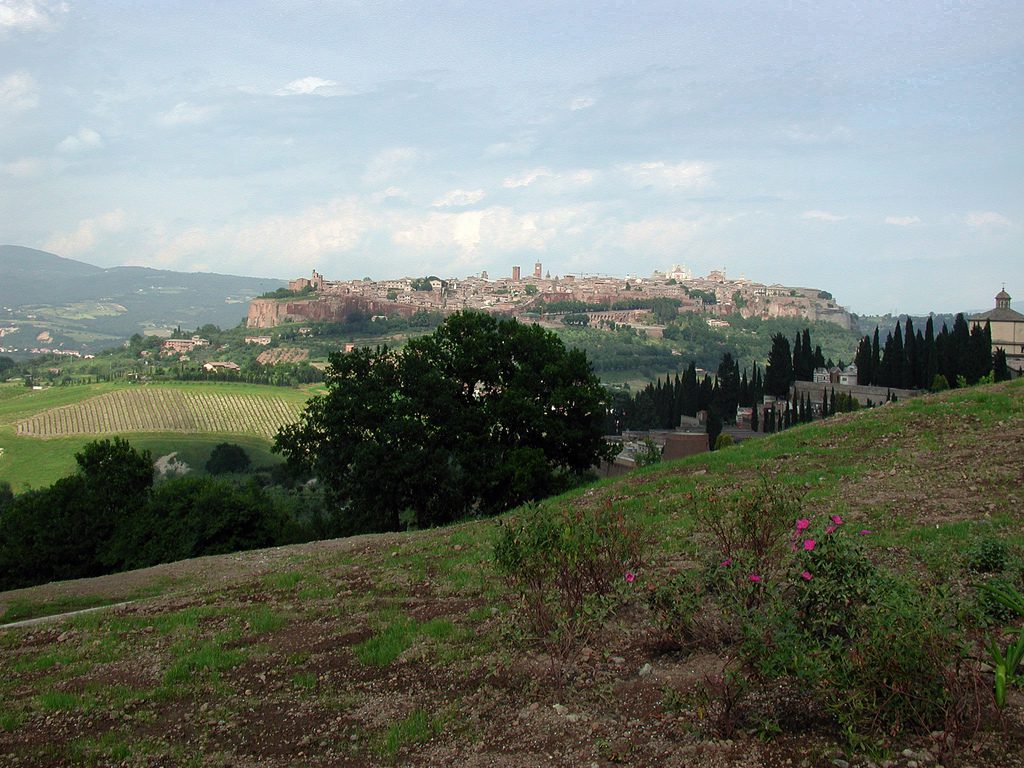From Orvieto to Todi, through the lake of Alviano and Montecastello di Vibio, this trip leads us along some of the most unspoiled Umbrian countrysides.
 Orvieto: the splendor of Gothic and Reinassance Art.
Orvieto: the splendor of Gothic and Reinassance Art.
Orvieto stands on the top of a steep rock, inhabited since Prehistory, but definitely urbanized under the Etruscans. Corso Cavour is the main axis of the historical center. We take left to via Duomo, cross piazza Gualtieri and the Medieval Torre di Maurizio, and then meet the Cathedral,a jewel of Romanesque and Gothic architecture. The imposing building resembles a huge reliquary, with its precious facade, where several late addition are well integrated into the original structure. Its foundations were laid in 1290 by Arnolfo di Cambio and then Lorenzo Maitani, but the building underwent several changes along the centuries. Inside the Cathedral, the Chapel of San Brizio is one the highlights of Italian Reinassance. Beato Angelico and Benozzo Gozzoli started frescoing its vaults in the middle of XV century, but the work was completed by Luca Signorelli, almost fifty years later. His powerful depiction of men, devils an angels was once believed to have influenced the work of Michelangelo. In the Cappella del Corporale, a splendid gold shrine guards the blood-stained linen testimonying Bolsena’s miracle (1263). Also noteworthy are Museo dell’Opera del Duomo, Museo Archeologico and the church of San Giovenale. Besides the Cathedral, the Papal Palaces and Palazzo Soliano, with the museum dedicated to XX century painter Emidio Greco. Back to corso Cavour, we walk through piazza della Repubblica, with the church of Sant’Andrea and an unusual dodecagonal tower, and Piazza del Popolo, and finally get to the Church of San Domenico, with the majestic, although partially ruined, tomb of Cardinal Guglielmo de Braye, built by Arnolfo di Cambio in 1282.
 The Lakes of Corbara and Alviano.
The Lakes of Corbara and Alviano.
A half an hour’s trip leads us to the lake of Corbara (Orvieto Scalo, SS 71, SS 79 bis, località Sette Martiri), an artificial basin created in 1959-1962. The area surrounding the lake is very rich in vineyards. Civitella del Lago overlooks the lake, offering a marvellous landscape. During the Easter period, the “Ovo Pinto” festival celebrates the ancient traditions of decorating the eggs. In the local museum, thousands of painted eggs are exposed, made by artists or amateurs. Not far from Corbara (ss 448 verso Rota, vocabolo Caiana, SS 205, Baschi, Castiglione), the lake of Alviano is another artificial basin. Its 2000 acres are protected by WWF and host a variety of migratory birds. According to the tradition, here San Francis persuaded a flock of swallow to stay silent, so that he could deliver his sermon. There are many franciscan friaries around the lake, suche as that of Pantanelli, where Jacopone da Todi composed his famous Stabat Mater. The fortress of Alviano, built in 1495, also deserve a visit. Heading South towards Lugnano for about 4 miles (SS205), we reach the friary of San Francesco, where the Saint is reported to have rescued a baby from a wolf. We continue towards North (SS 205, strada Piantoneto, strada Coccianesi) to visiti the small hermitage of Sant’Illuminata, founded by Saint Romualdo in the XI century.In poco meno di mezz’ora, lasciandoci alle spalle Orvieto, raggiungiamo il Lago di Corbara (Orvieto Scalo, SS 71, SS 79 bis, località Sette Martiri), un bacino artificiale con una superficie di dieci chilometri creato lungo il Tevere tra il 1959 e il 1962 grazie a una diga per lo sfruttamento dell’energia idroelettrica. Corbara è un territorio d’eccellenza sotto il profilo eno-gastronomico: la zona che circonda il bacino idrico è abbondante di vigneti che danno vita alla doc “Lago di Corbara”. Civitella del Lago è il borgo che sovrasta l’invaso di Corbara e il belvedere sullo specchio d’acqua offre uno dei panorami più belli dell’Umbria tutta: tipica del luogo è l’Ovo Pinto, una manifestazione basata sulla decorazione delle uova, pratica che trova le sue origini nel tradizionale rito dello scambio di uova durante il periodo pasquale. Un museo civico raccoglie e conserva migliaia di uova, di tutte le specie animali, dipinte o scolpite da artisti professionisti o da semplici amatori. Non lontano dal Lago di Corbara (ss 448 verso Rota, vocabolo Caiana, SS 205, Baschi, Castiglione) apre il bacino idrico del Lago di Alviano, risultato dello sbarramento artificiale del Tevere per la produzione di energia idroelettrica del 1963. Oasi Wwf, il Lago di Alviano si estende su una superficie di circa 900 ettari e ospita una grande varietà e quantità di fauna in migrazione (anatre, oche, folaghe) nota fin dai tempi di San Francesco, che qui avrebbe pregato le rondini di tacere per poter iniziare la sua predica: episodio, questo, meglio conosciuto come il “miracolo delle rondini”.


 Montecastello di Vibio and Tuderte’s Country.
Montecastello di Vibio and Tuderte’s Country.
In about an hour, we get to Montecastello di Vibio (SS 205 towards Guardea, Casaline, Montecchio, Case Nuove, SS 448, Pontecuti, Torrerosa, Canonica), across some of the most beautiful landscapes in Umbria. Montecastello has been described as a “lost paradise” by American anthropologist Sydel Silverman, in that it has retained his original Medieval look intact. Built in 1789, the Teatro della Concordia, with its 99 seats, is the smallest in the world. Nearby, the park of Monte Peglia and the Selva di Meana are interesting natural reserves. We get to Todi in twenty minutes (SS 397 towards Poggiolo, San Valentino, SS 3 bis), through country roads crossing the intact heart of rural Umbria.


Comment (0)